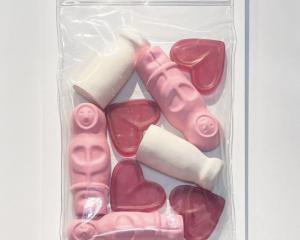Garry Currin has a way of creating atmospheric, ephemeral landscapes into which a viewer can project their own imaginary worlds.
Figures and forms are vague, shifting.
Shimmering forms appear from a monochromatic gloom like lights on a foggy night. In recent years, Currin's oil paintings have changed subtly. More colour is present, notably a lustrous fiery orange, and more recognisable features have started to appear. In his current exhibition, these features have become distinct distant landforms - hills, water and cliffs - leaving the foreground as an area of ambiguity. The size range of Currin's work has also extended, with works present ranging from a small curved panel to a massive airy work more than three metres in length.
Currin's work reflects the artist's environmental sensibilities; through the vague features, one can sense the natural land and the solid forms of human impact upon it. This is particularly evident in the "Untitled approach" paintings, which suggest the final descent of a light aircraft on to a runway imposed on an otherwise pristine countryside. The ground is laid bare to show the solid lines that form the eternal land's architectural sculpture; human creative activity is displayed in the foreground's wild gestural strokes, counterbalancing the gentle rugged nature of the background.
There is a seductiveness to Richard Orjis' digital overlays of bright coloured art objects against monochromatic backdrops, also at the Milford. Viewers are drawn into the artist's allegorical contemplations on wealth, beauty, impermanence, and mortality. The large-scale monochrome images are of Marie Antoinette's folly, a pseudo-Arcadian peasant village at Versailles. The village is a fiction, its picture-book cottages at odds with the true grime of French village life. The removal from ordinary life is emphasised by our knowledge of the fate which awaited the French queen. Overlaid on these scenes are images taken from auction catalogues of gaudy, expensive trinkets. There is a deliberate showiness to the jewels, a conscious display of affectation and wealth. This combination of the ancient and modern displays of wealth suggests history's economic and political cycles repeatedly leading us back to divisions of haves and have-nots. Orjis's complex, technically skilful images are not polemic - the message is often only vaguely implied. The ostensible subject is the paired architectural feature and jewelled design.
There is a wilful desire to juxtapose these images and, to use internet jargon, to "click through" from one feature to the next. This is confirmed in the works' titles - drawn from social media, they can be used as links to activate web pages.
Jon Thom presents a series of intimate portraits in his untitled exhibition at The Artist's Room.
Not only is the exhibition untitled (or, more correctly, titled "Untitled"), but so too are the images. The faces are deliberately anonymous, leaving any information about the subjects entirely to the viewer's imagination.
Thom's debut solo exhibition marks something of a departure from the acrylics that make up much of the artist's output. In these works, he has turned to a monochromatic medium, charcoal and compressed pastel, which Thom tends to prefer for its malleability and what the artist describes as its "messiness".
The hard, brittle colours of acrylic are abandoned for soft areas of rubbed shading, the surface worked to remove excess charcoal, returning the paper to a somewhat grimy white.
Thom's mysterious portraits are predominantly inspired by images found on the internet. The artist's experience with fashion photography has informed his choice of image, both in terms of the model-like women depicted and their often artificial poses.
The rubbed charcoal technique is very effective for these images, and one that has been well used by the artist. It creates a chiaroscuro tension while emphasising the graphic qualities (both literal and metaphorical) of the work.








![Untitled (c. mid 1990s, [pink 3]), by Martin Thompson, 415mm×590mm. Photo: courtesy of Brett...](https://www.odt.co.nz/sites/default/files/styles/odt_landscape_small_related_stories/public/story/2024/02/untitled_pink_3.jpg?itok=Q0aQrc9o)



